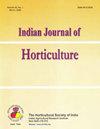Genetic diversity in cassava based on agronomical, physiological and est-microsatellite markers under moisture stress conditions
Q4 Agricultural and Biological Sciences
引用次数: 0
Abstract
Genetic diversity of 23 cassava accessions was studied using agro-physiological and EST-Microsatellite markers. Based on agronomical and physiological parameters the genotypes were classified into 6 clusters. Cluster-2 had highly 10 genotypes while the clusters-5 and 6 had single accession. The high yielding and highly drought tolerant genotype 8S501 stood alone in cluster-5. It had high cluster mean values for majority of the traits. The genotypes present in cluster-4 & 5 and cluster-1 & 2 were divergent and hybridization between these two groups may result in superior genotypes for drought tolerance. The EST-Microsatellites obtained from drought transcriptome of cassava showed that the mean number of alleles per locus was 1.81 with an average size of 217.7 basepairs (bp). The locus, MeESSR47 (Thylakoid membrane phosphoprotein 14 kDa, chloroplast precursor, putative), had more heterozygosity (0.387) and Shannon’s Index (0.575) among all the loci. These results cumulatively showed the low polymorphism in the EST regions of cassava DNA. The dendrogram showed 4 clusters based on EST Microsatellite diversity. The microsatellite based cluster classification of genotypes did not follow the diversity based on agronomical traits under moisture stress condition. A weak correlation revealed by Mantel test also indicated that there was no relation between agronomical and molecular diversity.水分胁迫条件下基于农艺学、生理学和雌微卫星标记的木薯遗传多样性
利用农业生理学和 EST-微卫星标记研究了 23 个木薯品种的遗传多样性。根据农艺和生理参数,基因型被分为 6 个群组。第 2 组有 10 个基因型,第 5 组和第 6 组只有一个品种。高产和高耐旱基因型 8S501 独自出现在第 5 组中。它在大多数性状上都有较高的聚类平均值。第 4 组和第 5 组以及第 1 组和第 2 组的基因型存在差异,这两组之间的杂交可能会产生抗旱性更强的优良基因型。从木薯干旱转录组中获得的EST-微卫星显示,每个位点的等位基因平均数量为 1.81 个,平均大小为 217.7 碱基对(bp)。在所有位点中,MeESSR47(叶绿体膜磷蛋白 14 kDa,叶绿体前体,推测)位点的杂合度(0.387)和香农指数(0.575)较高。这些结果综合显示了木薯 DNA EST 区域的低多态性。树枝图显示了基于 EST 微卫星多样性的 4 个聚类。在水分胁迫条件下,基于微卫星的基因型聚类分类与基于农艺性状的多样性并不一致。曼特尔检验(Mantel test)显示的弱相关性也表明农艺多样性与分子多样性之间没有关系。
本文章由计算机程序翻译,如有差异,请以英文原文为准。
求助全文
约1分钟内获得全文
求助全文
来源期刊

Indian Journal of Horticulture
农林科学-园艺
CiteScore
0.50
自引率
0.00%
发文量
22
审稿时长
4-8 weeks
期刊介绍:
Information not localized
 求助内容:
求助内容: 应助结果提醒方式:
应助结果提醒方式:


